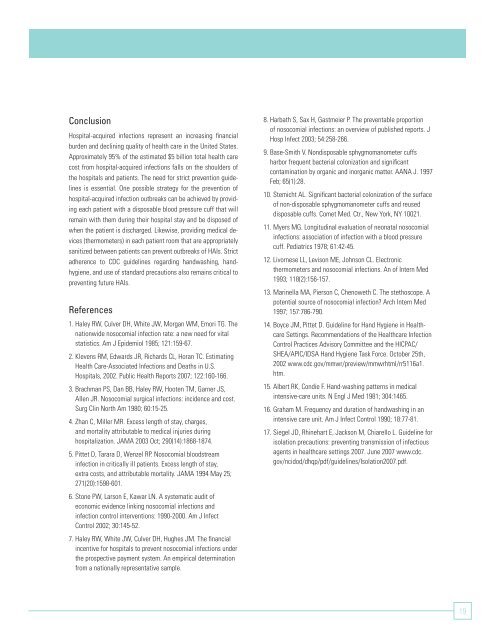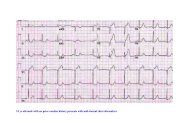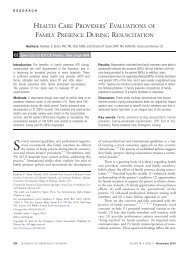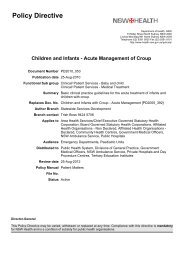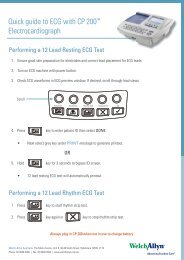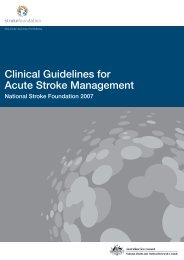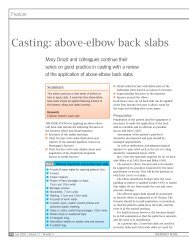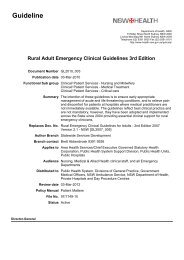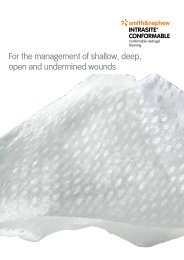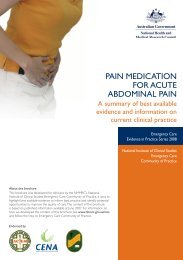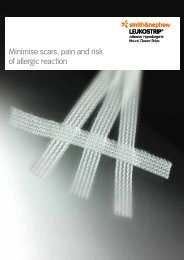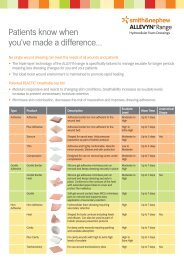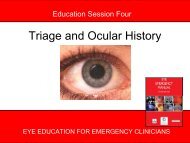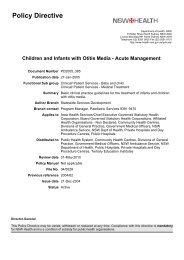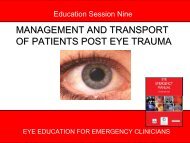Non Invasive Blood Pressure - Living on the EDge
Non Invasive Blood Pressure - Living on the EDge
Non Invasive Blood Pressure - Living on the EDge
Create successful ePaper yourself
Turn your PDF publications into a flip-book with our unique Google optimized e-Paper software.
C<strong>on</strong>clusi<strong>on</strong><br />
Hospital-acquired infecti<strong>on</strong>s represent an increasing financial<br />
burden and declining quality of health care in <strong>the</strong> United States.<br />
Approximately 95% of <strong>the</strong> estimated $5 billi<strong>on</strong> total health care<br />
cost from hospital-acquired infecti<strong>on</strong>s falls <strong>on</strong> <strong>the</strong> shoulders of<br />
<strong>the</strong> hospitals and patients. The need for strict preventi<strong>on</strong> guidelines<br />
is essential. One possible strategy for <strong>the</strong> preventi<strong>on</strong> of<br />
hospital-acquired infecti<strong>on</strong> outbreaks can be achieved by providing<br />
each patient with a disposable blood pressure cuff that will<br />
remain with <strong>the</strong>m during <strong>the</strong>ir hospital stay and be disposed of<br />
when <strong>the</strong> patient is discharged. Likewise, providing medical devices<br />
(<strong>the</strong>rmometers) in each patient room that are appropriately<br />
sanitized between patients can prevent outbreaks of HAIs. Strict<br />
adherence to CDC guidelines regarding handwashing, handhygiene,<br />
and use of standard precauti<strong>on</strong>s also remains critical to<br />
preventing future HAIs.<br />
References<br />
1. Haley RW, Culver DH, White JW, Morgan WM, Emori TG. The<br />
nati<strong>on</strong>wide nosocomial infecti<strong>on</strong> rate: a new need for vital<br />
statistics. Am J Epidemiol 1985; 121:159-67.<br />
2. Klevens RM, Edwards JR, Richards CL, Horan TC. Estimating<br />
Health Care-Associated Infecti<strong>on</strong>s and Deaths in U.S.<br />
Hospitals, 2002. Public Health Reports 2007; 122:160-166.<br />
3. Brachman PS, Dan BB, Haley RW, Hooten TM, Garner JS,<br />
Allen JR. Nosocomial surgical infecti<strong>on</strong>s: incidence and cost.<br />
Surg Clin North Am 1980; 60:15-25.<br />
4. Zhan C, Miller MR. Excess length of stay, charges,<br />
and mortality attributable to medical injuries during<br />
hospitalizati<strong>on</strong>. JAMA 2003 Oct; 290(14):1868-1874.<br />
5. Pittet D, Tarara D, Wenzel RP. Nosocomial bloodstream<br />
infecti<strong>on</strong> in critically ill patients. Excess length of stay,<br />
extra costs, and attributable mortality. JAMA 1994 May 25;<br />
271(20):1598-601.<br />
6. St<strong>on</strong>e PW, Lars<strong>on</strong> E, Kawar LN. A systematic audit of<br />
ec<strong>on</strong>omic evidence linking nosocomial infecti<strong>on</strong>s and<br />
infecti<strong>on</strong> c<strong>on</strong>trol interventi<strong>on</strong>s: 1990-2000. Am J Infect<br />
C<strong>on</strong>trol 2002; 30:145-52.<br />
7. Haley RW, White JW, Culver DH, Hughes JM. The financial<br />
incentive for hospitals to prevent nosocomial infecti<strong>on</strong>s under<br />
<strong>the</strong> prospective payment system. An empirical determinati<strong>on</strong><br />
from a nati<strong>on</strong>ally representative sample.<br />
8. Harbath S, Sax H, Gastmeier P. The preventable proporti<strong>on</strong><br />
of nosocomial infecti<strong>on</strong>s: an overview of published reports. J<br />
Hosp Infect 2003; 54:258-266.<br />
9. Base-Smith V. <str<strong>on</strong>g>N<strong>on</strong></str<strong>on</strong>g>disposable sphygmomanometer cuffs<br />
harbor frequent bacterial col<strong>on</strong>izati<strong>on</strong> and significant<br />
c<strong>on</strong>taminati<strong>on</strong> by organic and inorganic matter. AANA J. 1997<br />
Feb; 65(1):28.<br />
10. Stemicht AL. Significant bacterial col<strong>on</strong>izati<strong>on</strong> of <strong>the</strong> surface<br />
of n<strong>on</strong>-disposable sphygmomanometer cuffs and reused<br />
disposable cuffs. Comet Med. Ctr., New York, NY 10021.<br />
11. Myers MG. L<strong>on</strong>gitudinal evaluati<strong>on</strong> of ne<strong>on</strong>atal nosocomial<br />
infecti<strong>on</strong>s: associati<strong>on</strong> of infecti<strong>on</strong> with a blood pressure<br />
cuff. Pediatrics 1978; 61:42-45.<br />
12. Livornese LL, Levis<strong>on</strong> ME, Johns<strong>on</strong> CL. Electr<strong>on</strong>ic<br />
<strong>the</strong>rmometers and nosocomial infecti<strong>on</strong>s. An of Intern Med<br />
1993; 118(2):156-157.<br />
13. Marinella MA, Piers<strong>on</strong> C, Chenoweth C. The stethoscope. A<br />
potential source of nosocomial infecti<strong>on</strong>? Arch Intern Med<br />
1997; 157:786-790.<br />
14. Boyce JM, Pittet D. Guideline for Hand Hygiene in Healthcare<br />
Settings. Recommendati<strong>on</strong>s of <strong>the</strong> Healthcare Infecti<strong>on</strong><br />
C<strong>on</strong>trol Practices Advisory Committee and <strong>the</strong> HICPAC/<br />
SHEA/APIC/IDSA Hand Hygiene Task Force. October 25th,<br />
2002 www.cdc.gov/mmwr/preview/mmwrhtml/rr5116a1.<br />
htm.<br />
15. Albert RK, C<strong>on</strong>die F. Hand-washing patterns in medical<br />
intensive-care units. N Engl J Med 1981; 304:1465.<br />
16. Graham M. Frequency and durati<strong>on</strong> of handwashing in an<br />
intensive care unit. Am J Infect C<strong>on</strong>trol 1990; 18:77-81.<br />
17. Siegel JD, Rhinehart E, Jacks<strong>on</strong> M, Chiarello L. Guideline for<br />
isolati<strong>on</strong> precauti<strong>on</strong>s: preventing transmissi<strong>on</strong> of infectious<br />
agents in healthcare settings 2007. June 2007 www.cdc.<br />
gov/ncidod/dhqp/pdf/guidelines/Isolati<strong>on</strong>2007.pdf.<br />
19<br />
SM4002 ICT4ECR.indd 19<br />
3/30/09 3:19:32 PM


